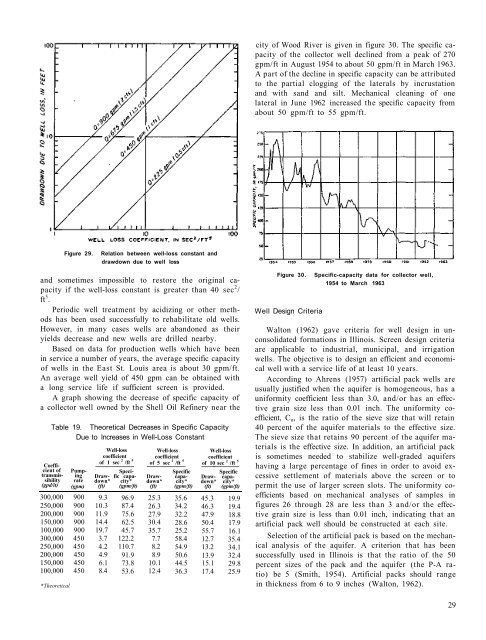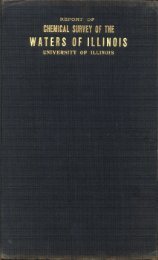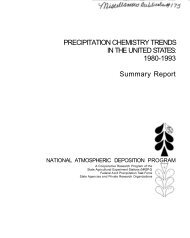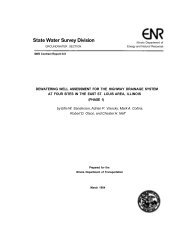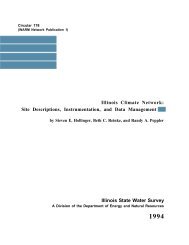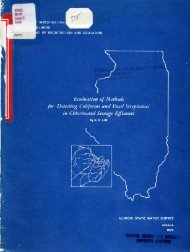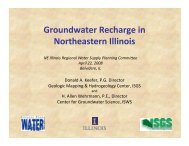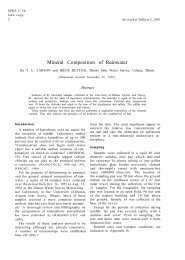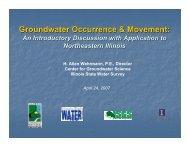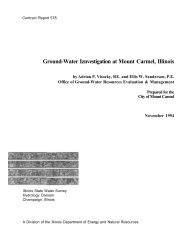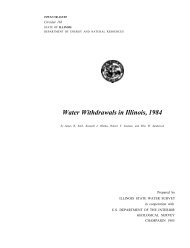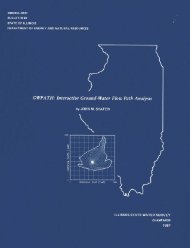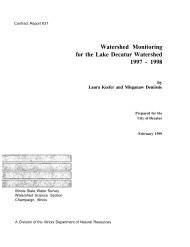Ground-water development in East St. Louis area, Illinois. Urbana, IL ...
Ground-water development in East St. Louis area, Illinois. Urbana, IL ...
Ground-water development in East St. Louis area, Illinois. Urbana, IL ...
You also want an ePaper? Increase the reach of your titles
YUMPU automatically turns print PDFs into web optimized ePapers that Google loves.
city of Wood River is given <strong>in</strong> figure 30. The specific capacity<br />
of the collector well decl<strong>in</strong>ed from a peak of 270<br />
gpm/ft <strong>in</strong> August 1954 to about 50 gpm/ft <strong>in</strong> March 1963.<br />
A part of the decl<strong>in</strong>e <strong>in</strong> specific capacity can be attributed<br />
to the partial clogg<strong>in</strong>g of the laterals by <strong>in</strong>crustation<br />
and with sand and silt. Mechanical clean<strong>in</strong>g of one<br />
lateral <strong>in</strong> June 1962 <strong>in</strong>creased the specific capacity from<br />
about 50 gpm/ft to 55 gpm/ft.<br />
Figure 29.<br />
Relation between well-loss constant and<br />
drawdown due to well loss<br />
and sometimes impossible to restore the orig<strong>in</strong>al capacity<br />
if the well-loss constant is greater than 40 sec 2 /<br />
ft 5 .<br />
Periodic well treatment by acidiz<strong>in</strong>g or other methods<br />
has been used successfully to rehabilitate old wells.<br />
However, <strong>in</strong> many cases wells are abandoned as their<br />
yields decrease and new wells are drilled nearby.<br />
Based on data for production wells which have been<br />
<strong>in</strong> service a number of years, the average specific capacity<br />
of wells <strong>in</strong> the <strong>East</strong> <strong>St</strong>. <strong>Louis</strong> <strong>area</strong> is about 30 gpm/ft.<br />
An average well yield of 450 gpm can be obta<strong>in</strong>ed with<br />
a long service life if sufficient screen is provided.<br />
A graph show<strong>in</strong>g the decrease of specific capacity of<br />
a collector well owned by the Shell Oil Ref<strong>in</strong>ery near the<br />
Table 19. Theoretical Decreases <strong>in</strong> Specific Capacity<br />
Due to Increases <strong>in</strong> Well-Loss Constant<br />
Coefficient<br />
of<br />
transmissibility<br />
(gpd/it)<br />
Pump<strong>in</strong>g<br />
rate<br />
(gpm)<br />
Well-loss<br />
coefficient<br />
of 1 sec 2 /ft 5<br />
Speci-<br />
Draw- fic capadown*<br />
city*<br />
(ft) (gpm/ft)<br />
Well-loss<br />
coefficient<br />
of 5 sec 2 /ft 5<br />
Well-loss<br />
coefficient<br />
of 10 sec 2 /ft 5<br />
Specific<br />
capa-<br />
city*<br />
(gpm/ft)<br />
Drawdown*<br />
(ft)<br />
Specific<br />
Draw- capadown*<br />
city*<br />
(ft) (gpm/ft)<br />
300,000 900 9.3 96.9 25.3 35.6 45.3 19.9<br />
250,000 900 10.3 87.4 26.3 34.2 46.3 19.4<br />
200,000 900 11.9 75.6 27.9 32.2 47.9 18.8<br />
150,000 900 14.4 62.5 30.4 28.6 50.4 17.9<br />
100,000 900 19.7 45.7 35.7 25.2 55.7 16.1<br />
300,000 450 3.7 122.2 7.7 58.4 12.7 35.4<br />
250,000 450 4.2 110.7 8.2 54.9 13.2 34.1<br />
200,000 450 4.9 91.9 8.9 50.6 13.9 32.4<br />
150,000 450 6.1 73.8 10.1 44.5 15.1 29.8<br />
100,000 450 8.4 53.6 12.4 36.3 17.4 25.9<br />
*Theoretical<br />
Figure 30.<br />
Well Design Criteria<br />
Specific-capacity data for collector well,<br />
1954 to March 1963<br />
Walton (1962) gave criteria for well design <strong>in</strong> unconsolidated<br />
formations <strong>in</strong> Ill<strong>in</strong>ois. Screen design criteria<br />
are applicable to <strong>in</strong>dustrial, municipal, and irrigation<br />
wells. The objective is to design an efficient and economical<br />
well with a service life of at least 10 years.<br />
Accord<strong>in</strong>g to Ahrens (1957) artificial pack wells are<br />
usually justified when the aquifer is homogeneous, has a<br />
uniformity coefficient less than 3.0, and/or has an effective<br />
gra<strong>in</strong> size less than 0.01 <strong>in</strong>ch. The uniformity coefficient,<br />
C u , is the ratio of the sieve size that will reta<strong>in</strong><br />
40 percent of the aquifer materials to the effective size.<br />
The sieve size that reta<strong>in</strong>s 90 percent of the aquifer materials<br />
is the effective size. In addition, an artificial pack<br />
is sometimes needed to stabilize well-graded aquifers<br />
hav<strong>in</strong>g a large percentage of f<strong>in</strong>es <strong>in</strong> order to avoid excessive<br />
settlement of materials above the screen or to<br />
permit the use of larger screen slots. The uniformity coefficients<br />
based on mechanical analyses of samples <strong>in</strong><br />
figures 26 through 28 are less than 3 and/or the effective<br />
gra<strong>in</strong> size is less than 0.01 <strong>in</strong>ch, <strong>in</strong>dicat<strong>in</strong>g that an<br />
artificial pack well should be constructed at each site.<br />
Selection of the artificial pack is based on the mechanical<br />
analysis of the aquifer. A criterion that has been<br />
successfully used <strong>in</strong> Ill<strong>in</strong>ois is that the ratio of the 50<br />
percent sizes of the pack and the aquifer (the P-A ratio)<br />
be 5 (Smith, 1954). Artificial packs should range<br />
<strong>in</strong> thickness from 6 to 9 <strong>in</strong>ches (Walton, 1962).<br />
29


